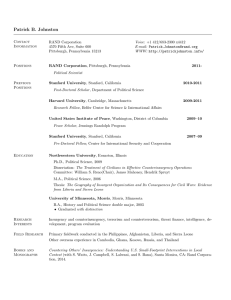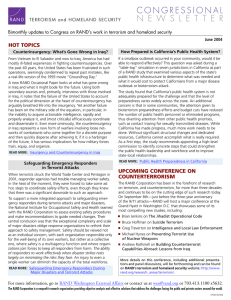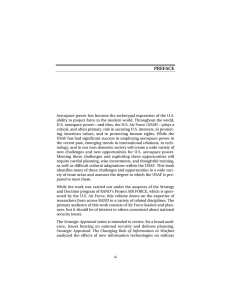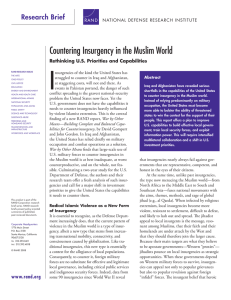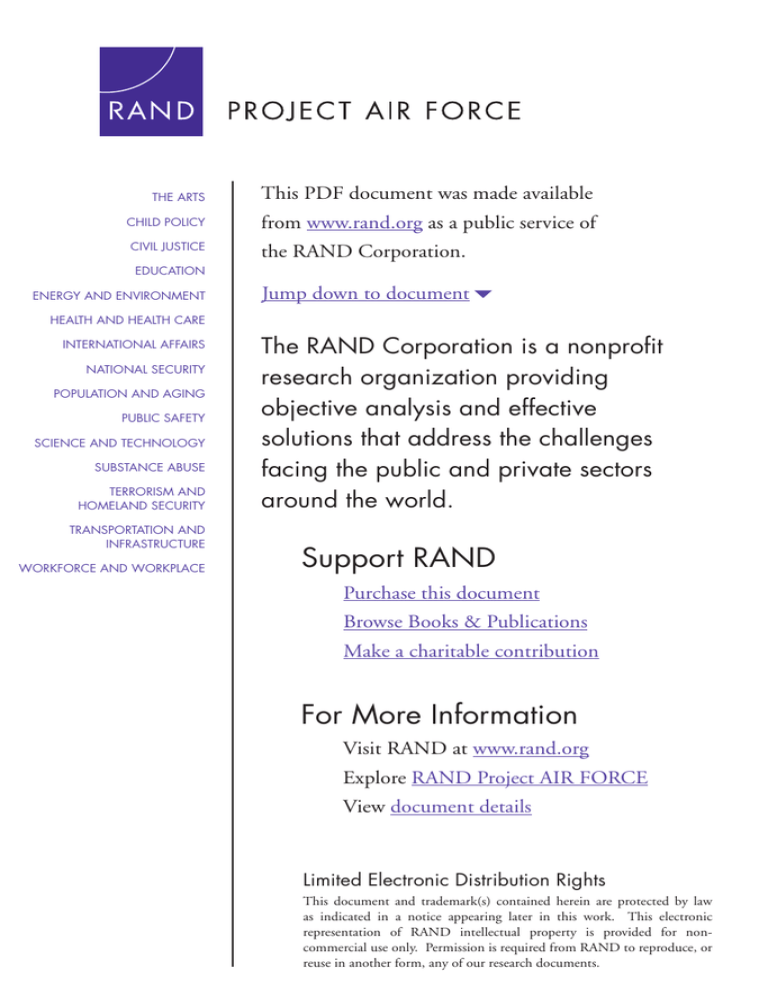
THE ARTS
This PDF document was made available
CHILD POLICY
from www.rand.org as a public service of
CIVIL JUSTICE
the RAND Corporation.
EDUCATION
ENERGY AND ENVIRONMENT
Jump down to document6
HEALTH AND HEALTH CARE
INTERNATIONAL AFFAIRS
NATIONAL SECURITY
POPULATION AND AGING
PUBLIC SAFETY
SCIENCE AND TECHNOLOGY
SUBSTANCE ABUSE
TERRORISM AND
HOMELAND SECURITY
TRANSPORTATION AND
INFRASTRUCTURE
WORKFORCE AND WORKPLACE
The RAND Corporation is a nonprofit
research organization providing
objective analysis and effective
solutions that address the challenges
facing the public and private sectors
around the world.
Support RAND
Purchase this document
Browse Books & Publications
Make a charitable contribution
For More Information
Visit RAND at www.rand.org
Explore RAND Project AIR FORCE
View document details
Limited Electronic Distribution Rights
This document and trademark(s) contained herein are protected by law
as indicated in a notice appearing later in this work. This electronic
representation of RAND intellectual property is provided for noncommercial use only. Permission is required from RAND to reproduce, or
reuse in another form, any of our research documents.
This product is part of the RAND Corporation monograph series.
RAND monographs present major research findings that address the
challenges facing the public and private sectors. All RAND monographs undergo rigorous peer review to ensure high standards for
research quality and objectivity.
Air Power in the New
Counterinsurgency Era
The Strategic Importance of USAF
Advisory and Assistance Missions
Alan J. Vick, Adam Grissom, William Rosenau, Beth Grill,
Karl P. Mueller
Prepared for the United States Air Force
Approved for public release; distribution unlimited
PROJECT AIR FORCE
The research described in this report was sponsored by the United States
Air Force under Contract F49642-01-C-0003. Further information may
be obtained from the Strategic Planning Division, Directorate of Plans,
Hq USAF.
Library of Congress Cataloging-in-Publication Data
Air power in the new counterinsurgency era : the strategic importance of USAF
advisory and assistance missions / Alan J. Vick ... [et al.].
p. cm.
“MG-509.”
Includes bibliographical references.
ISBN-13: 978-0-8330-3963-7 (pbk. : alk. paper)
1. Counterinsurgency—United States. 2. Air power—United States. 3. United
States. Air Force. 4. Military assistance, American 5. Military missions. 6. World
politics—21st century. I. Vick, Alan.
U241.A57 2006
358.4'1425—dc22
2006019803
The RAND Corporation is a nonprofit research organization providing
objective analysis and effective solutions that address the challenges
facing the public and private sectors around the world. RAND’s
publications do not necessarily reflect the opinions of its research clients
and sponsors.
R® is a registered trademark.
Cover image of CT team: Combat Aviation Advisors from the 6th SOS and regular
army soldiers from Chad in front of a Chad Air Force C-130.
© Copyright 2006 RAND Corporation
All rights reserved. No part of this book may be reproduced in any
form by any electronic or mechanical means (including photocopying,
recording, or information storage and retrieval) without permission in
writing from RAND.
Published 2006 by the RAND Corporation
1776 Main Street, P.O. Box 2138, Santa Monica, CA 90407-2138
1200 South Hayes Street, Arlington, VA 22202-5050
4570 Fifth Avenue, Suite 600, Pittsburgh, PA 15213
RAND URL: http://www.rand.org/
To order RAND documents or to obtain additional information, contact
Distribution Services: Telephone: (310) 451-7002;
Fax: (310) 451-6915; Email: order@rand.org
Summary
Often treated by Americans as an exceptional form of warfare, insurgency is anything but. Spanning the globe, centuries, and societies,
insurgency is quite common. The United States itself was founded
by insurgents—British colonists who rebelled against the abuses and
neglect of British rule. At the end of the 19th century, the United
States fought Filipino insurgents in its newly won territory. During
the 20th century, U.S. forces fought insurgents in Nicaragua; Haiti;
the Dominican Republic; the Philippines (again); Vietnam; and most
recently, Afghanistan and Iraq. It has provided support to counterinsurgent forces in many more locations and support to insurgents in a
few (most notably Nicaragua and Afghanistan).
This monograph seeks to help USAF prepare for future insurgency challenges by describing current trends, presenting an overview
of key counterinsurgency principles, exploring counterinsurgency
grand strategy options for the United States, proposing a new precautionary approach to counterinsurgency, and assessing current and
potential USAF contributions.
Key Findings
• The primary insurgent threat to the United States today stems
from regional rebels and global terrorists who share a common
ideology.1 These ties allow global terrorists to use a local insur-
1
Throughout this report we use insurgent and rebel interchangeably.
xv
xvi
Air Power in the New Counterinsurgency Era
•
•
•
•
•
•
•
gency as a training ground, to provide sanctuary, and to motivate
a global audience (pp. 3–4).
Today the only terrorist group with both the capability and desire
to conduct attacks against U.S. interests at home and abroad is al
Qaeda (pp. 24, 55).
The U.S. counterinsurgency priority, therefore, should be the
insurgencies motivated by radical Islam and global jihad. These
are the ones most likely to find common cause with al Qaeda
(p. 58).
Previous experience with insurgencies has demonstrated that
insurgencies are rarely defeated by outside powers. Rather, the
best role for outsiders is an indirect one: training, advising, and
equipping the local nation, which must win the war politically
and militarily (pp. 4–5).
A precautionary strategy that seeks to defeat the insurgency in its
early stages is the most cost-effective approach, potentially avoiding huge costs in lives and dollars (pp. 82–93).
Because insurgencies are fundamentally driven by social, political, and economic issues, nonmilitary aid will often be most
important, especially in the early phases of a rebellion. Support to
the host nation’s police, security, and intelligence organizations is
especially critical and should precede or occur in parallel with military assistance. When they are necessary, military actions must
be carefully designed to support the overall political strategy. In
past insurgencies, ill-considered actions by the government’s military and security forces often increased insurgent determination
and popular support for the rebels. The United States and leaders
of partner nations must take care lest the military dynamic overtake the political (pp. 37–41, 45–47).
Because air power has much to contribute to counterinsurgencies
around the globe, advising, training, and equipping partner air
forces will be a key component of U.S. counterinsurgency efforts
(pp. 109–114).
USAF needs a full-spectrum counterinsurgency capability.
Although training, advising, and equipping efforts will be USAF’s
most common role in counterinsurgency, some situations may
Summary
xvii
require U.S. combat air power to team with indigenous or coalition ground forces or to participate in joint and interagency U.S.
counterinsurgency operations (pp. 146–147).
Recommendations for USAF
USAF possesses a broad range of capabilities, in both its special and
general-purpose forces, that can make significant contributions to
fighting insurgents. Bringing these capabilities to bear on the counterinsurgency problem will require that counterinsurgency be treated as
a problem as important as conventional warfighting, even though the
manpower, dollars, and force structure devoted to it will likely never
need to be as large as those devoted to major combat operations. To
enhance its contribution to counterinsurgency, USAF should take the
following steps:
• Make counterinsurgency an institutional priority. Without
clear signals from senior USAF leaders, the institutional USAF
will continue to treat counterinsurgency either as something that
only the Air Force Special Operations Command (AFSOC) does
or as a lesser included case that requires no special preparation.
Major speeches, vision statements, personnel policy changes,
and new programs will be necessary to overcome this perception
(p. 133).
• Create organizations and processes to oversee USAF counterinsurgency efforts. The USAF will need new organizations to
develop and oversee counterinsurgency policy and concepts, to
integrate efforts across the USAF, to coordinate with DoD and
other agencies, and to execute counterinsurgency advisory and
assistance missions (pp. 133, 135).
• Develop and nurture counterinsurgency expertise throughout USAF. Counterinsurgency expertise does exist in USAF, but,
outside of AFSOC, it is scattered and limited. Substantial counterinsurgency education should be a mandatory part of the cur-
xviii
Air Power in the New Counterinsurgency Era
riculum in the Air Force Reserve Officer Training Corps, at the
Air Force Academy, and in all phases of Air Force Professional
Military Education from Squadron Officer School to the Air War
College. Opportunities for more in-depth training and education
will need to be developed, as will appropriate career paths for
counterinsurgency specialists (pp. 135–136).
• Create a wing-level organization for aviation advising. This
is likely the single most important initiative USAF can take to
enhance its own counterinsurgency capabilities. By creating
a wing-level organization, USAF will be able to grow its advisory capacity to meet the demand; expand aviation assistance to
include institutional and higher-level advising; develop new counterinsurgency concepts and technologies for partner air forces;
supervise an embedded advisor program; and offer sufficiently
diverse opportunities to attract and retain the very best officers,
noncommissioned officers, and civilian personnel (pp. 136–143).
• Enhance USAF combat capabilities for counterinsurgency.
Although only as a last resort, USAF does need the ability to
conduct air operations in support of partner-nation forces and/or
U.S. joint forces fighting insurgencies. USAF already has considerable relevant capabilities, and its modernization programs
will enhance them further. Beyond that, specific technologies
(e.g., foliage-penetrating sensors) and, most important, a deeper
understanding of the insurgent phenomenon will increase the
effectiveness of air power in future counterinsurgency operations
(pp. 146–147).

